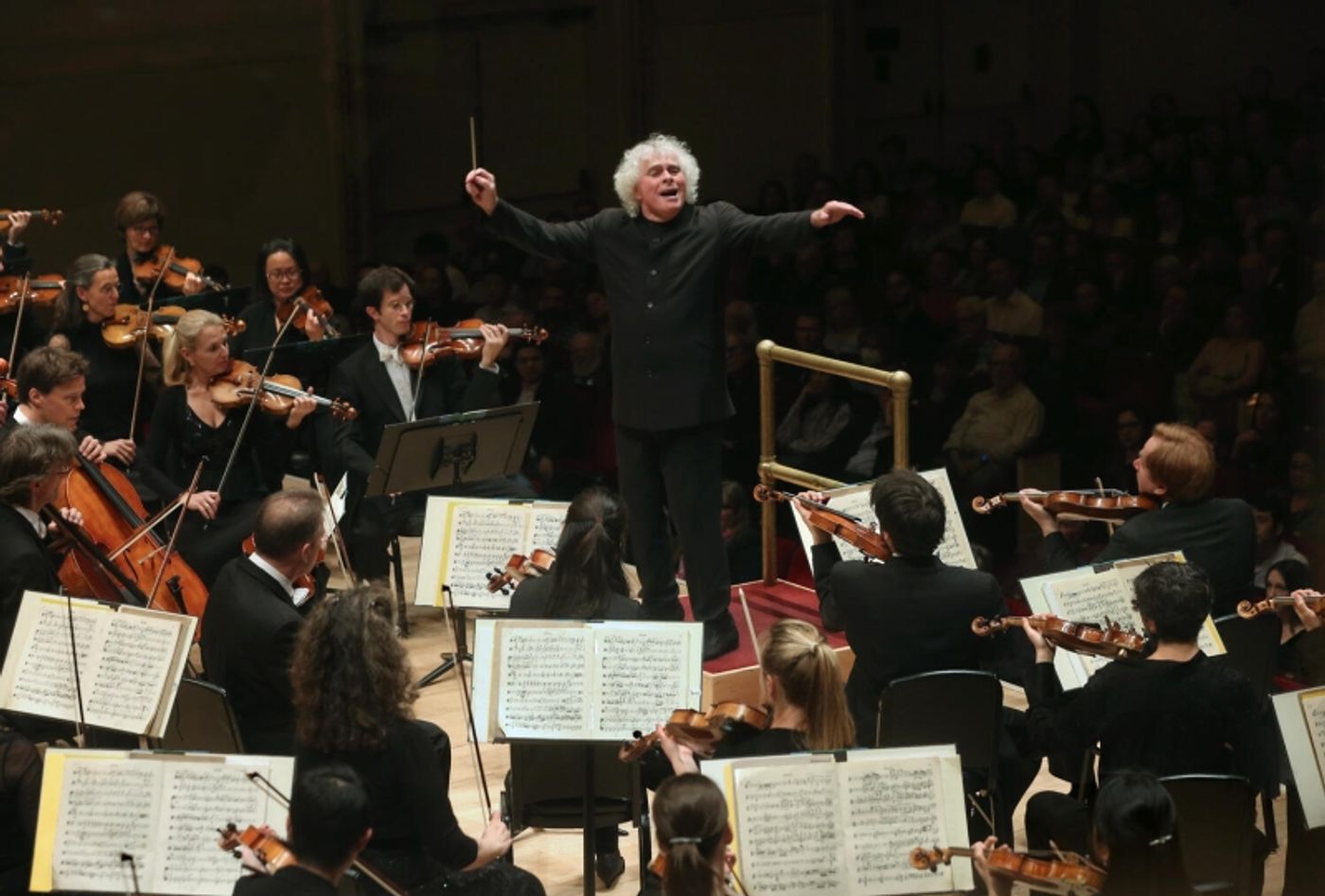Review: SIMON RATTLE AND THE BRSO AT CARNEGIE HALL at Carnegie Hall
An eclectic program highlighted by Mahler 6th

Simon Rattle is possibly the most interesting conductor before the public today. And one thing audiences can count on is that no two performances he conducts will ever be identical. There is no question that he brings forth fire and magical playing. There is no question he bring forth colors that you never heard in a piece before. But sometimes, one wonders if its all simply design just to sound different, not necessarily better than the rest.

Maestro Rattle took the reins of the Bavarian Radio Symphony Orchestra last fall and this was their first visit to Carnegie under their new leader. Frequently the Mahler 6th is presented by itself in a program, but this time Sir Simon decided to place it after the interval (make for a long – but never boring – evening!) The program began with Paul Hindemith’s “Ragtime (Well-Tempered),” a delightful short piece from 1921. The piece is a wonderful theme and variation on the Bach, all set in a frolicking 20’s rag. It was certainly an interesting choice to start off what was essentially a Mahler evening, but it was very enjoyable.
The second piece on the program was also a novel choice: Alexander Zemlinsky’s “Symphonische Gesänge.” This wonderful piece (also from the 1920s) is a song cycle, which, interestingly enough, is based on a German translation of seven poems by American poet, Langston Hughes.
.jpg?format=auto&width=1400)
The soloist, bass-baritone Lester Lynch was a revelation! His ardent and highly nuanced delivery and attention to the text made a clear and deep connection with the audience – which rewarded him with a long and loud ovation at the conclusion of the piece. It was this critic’s first hearing of Mr. Lynch, but here’s hoping he returns to the NY concert stage soon (and often!)
The second half of the performance was dedicated to the Mahler.
The mighty BRSO's performance was nothing short of ferocious. Rattle’s brisk tempo for the Allegro felt like a sprite military march with a powerful and steady pulse. He brought forth tremendous energy from the players and paid careful attention to extremely small details - particularly the well-balanced distribution of single melodies as they were passed between instruments.
The standard sonata form of the first movement, which even contains an exact repeat of the primary exposition, is unusual in Mahler, but Rattle brought a significantly higher level of intensity to the second pass, raising the stakes and tension of the movement.

The maestro choose to perform the work not in its original sequence of movements, with the Scherzo second and the Andante third, but rather with the Andante second - not the preferred configuration of this critic, both because it speaks to the traditional origins of the symphony and because the Scherzo is a variation on the material from the first movement. When the Scherzo is place third, after the Andante, that thematic link is broken.
The magical "Alma Theme" was introduced at a noticeably slower tempo than we are used to from Rattle, setting it off nicely from the more pulsating rhythmic structure of the 1st movement. In a stroke of brilliance, the legendary cowbells were placed deeply offstage, creating a distant and mystical sound. They spoke of the mountains and the pastures where Mahler sought and found his inspiration. In many performances of the 6th, the cowbells are an annoying rattling noise, breaking the flow. The placement of the cowbells offstage added a multi-dimensional quality to the sound, an evocative nostalgic and natural element that fit perfectly. The majestic Alma theme rose in a massive cathartic burst, leaving few dry eyes in the hall. The ravishing Andante was the evening's highlight. The maestro minimized portamenti and sentimentality throughout the evening, so the great build to the soaring major theme of the Andante was a miraculously cathartic and life-affirming power moment.
The scherzo movement can be a sluggish scherzo recapitulation of themes established in the 1st movement, but Rattle continually found new colors and in the sound and pulled forward instrumentation often buried in the score.
The mysterious and epically-long final movement was replete with nail-biting tension and massive explosions of sound. To his credit, the conductor navigated the irregular fluctuations of tempo and dynamics with a minimum of histrionics. He managed to dig deep into the orchestra and bring forward a sound that was chamber-like at some moments and Wagnerian in others.
The orchestra's playing was nothing short of outstanding. Particular kudos must be handed out to the multitude of marvelous soloists featured over the course of the evening.
Maestro Rattle never disappoints in delivering marvelously idiosyncratic performances. His thoughtful and idiomatic Mahler was certainly one of the season's highlights.
Peter Danish
Photos: Steven Sherman
Reader Reviews
Videos

